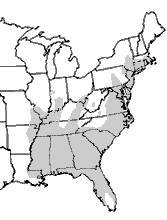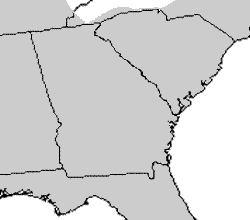Eastern Spadefoot Toad (Scaphiopus holbrookii)
Eastern Spadefoot Toad (Scaphiopus holbrookii)



Eastern Spadefoot Toad call
Description: A medium to large toad, 4–8 cm (1.6–3.1 in) in length. The skin is smoother and moister than that of other toads, with fine warts scattered across the dorsum. Coloration ranges from tan or yellowish to dark brown, typically lacking bold dorsal spots. Two vertical light lines extend from behind the eyes down the back, often joining to form an hourglass pattern; these lines are often brighter in males. Diagnostic features include striking yellow eyes with vertical, elliptical pupils (cat-like) and a distinct dark, keratinized spade on each hind foot used for digging.
Range and Habitat: It is widely distributed across the eastern United States. In the Southeast, it is most abundant in the Coastal Plain and scattered in the Piedmont, but absent from the high elevations of the Appalachians. It prefers dry, sandy habitats but may occur in a wide range of terrestrial environments, including suburban and agricultural areas. Breeding occurs in temporary, fishless pools, roadside ditches, and even large puddles.
Habits: Highly fossorial, spending the majority of the year buried underground. Emerges in masses following heavy rains at almost any time of year to breed in ephemeral wetlands, making this species an “explosive breeder.” Males call while floating at the water surface. Females lay up to 2,500 eggs, which hatch quickly; tadpoles can metamorphose in as little as 28 days. Populations may persist for years without successful reproduction. Long-lived individuals have been documented at the Savannah River Ecology Laboratory.
Call: A low-pitched, nasal “waaah,” repeated at short intervals.
Interesting Facts:
- Sometimes reported to have an odor reminiscent of peanut butter.
- Handling may cause some people allergic reactions (sneezing, wheezing, red eyes).
Conservation Status: It is not protected and locally common in the Southeast, but it is considered a conservation concern in the northern parts of its range. It is vulnerable to habitat loss, especially the destruction of ephemeral wetlands.

